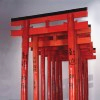The history of the famous Nezu Jinja Shrine in the heart of Tokyo is based on both legend and fact. Legend says the shrine was founded about two thousand years ago in Sendagi village, near its present site, as a token of respect to the god of war. The shrine was later moved nearby to Nezu, Tokyo and completed in 1706. There is a magnificent temple, which proved worthy of its new status as tutelary shrine to the sixth shogun, Tenobu Ienobu. However, Ienobu's father apparently killed a retainer, so from that day forward never knew a moment's rest; he may have committed suicide. In any event, history and legend became so intertwined that almost any story of the Edo epoch worthy of its name contains a play on words, such as in a popular satirical poem: "By his lordship's pillow/The ghost of Nezu/Sleepless, stands guard." Here the pun is on nezu, which means, "without sleeping" and is also the name of the slain retainer and of the district and its shrine. It is one of only three shrines designated an Important Cultural Property in the whole city and is the largest and best preserved.
Standing in front of one of Tokyo's important shrines the first time in 1998 was overwhelming. It is situated in a mass of greenery, forming riveting focal point by virtue of its brilliant red paint and the numerous arches one may use to approach it, extending on either side of the main gate and hall of the meditation area. I was in awe of the shrine's legend, history and appearance. Consequently, I decided to quantify and transform it into my own vocabulary, hence my own "sleepless nights" in reflecting, interpreting, creating and completing my version of Nezu Jinja Shrine. I made seven red seven-foot high ceramic gates reinterpreting the original Nezu Jinja Shrine gates. I want the viewer to move through my gates in denial of a static point of view that is common in the West. The calligraphy on the posts of my gates represents names of major donors along with good wishes for them for such support, similar to inscriptions on the gates of at Japanese shrines.
